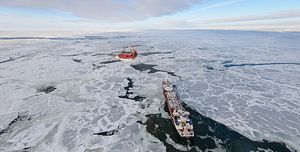The first Belt and Road Forum for International Cooperation closed in Beijing on May 15. The forum attracted 29 heads of state and government and delivered a series of cooperation agreements. This forum is seen by the Chinese government as a concrete move to revive the ancient Silk Road. The signature foreign policy initiative of Chinese President Xi Jinping, the Belt and Road, is of unprecedented geographical and financial scope.
Against this background, China has been showing strong interest in the resource-rich Arctic. Xi visited Finland before his state visit to the United States in April and stopped by Alaska on the way back to China. Earlier, on March 29, Chinese Vice Premier Wang Yang attended the opening ceremony of the fourth International Arctic Forum in Arkhangelsk, Russia and gave a speech which further elaborates China’s Arctic policy objectives. The question, therefore, is whether the Belt and Road Initiative, arguably the largest overseas investment drive ever launched by a single country, will help China achieve its Arctic policy goals.
The three main pillars of China’s Arctic policy are respect, cooperation, and sustainability.
The starting point of China’s engagement with the Arctic is mutual respect: China recognizes Arctic states’ sovereignty and sovereign rights, while the Arctic states should respect China’s legitimate rights in the Arctic under international law, such as freedom of navigation.
Cooperation for win-win outcomes is the key pillar of China’s Arctic policy. The Belt and Road Initiative could potentially help operationalize this objective. More than 60 countries, listed by China, are involved in the Belt and Road, and most of the countries are China’s neighbors. Russia is one of China’s most important partners in the Belt and Road Initiative, especially when it comes to the Silk Road Economic Belt in Eurasia (the Belt). Russia so far provides the main link between the Belt and Road and the Arctic.
The Silk Road Fund, established by China on December 29, 2014, holds a 9.9 percent share of the Yamal LNG project, a large liquefied natural gas project located in the Russian Arctic, while the China National Petroleum Company holds 20 percent, Novatek, Russia’s second-largest natural gas producer, 50.1 percent, and French oil giant Total, 20 percent. If all goes well, the Yamal LNG Project could be a convincing example for China’s Belt and Road Initiative to invest infrastructure projects in other part of the Arctic.
Nordic countries have also expressed interest in cooperating with China in the Arctic. For example, Finland and China agreed during Xi’s visit that the two countries will intensify economic and technological cooperation in the fields of arctic marine industry. After the normalization of bilateral relations between Norway and China, it is expected that the two countries’ Arctic cooperation will grow significantly. Although the Belt and Road Initiative does not include Nordic countries, Denmark, Norway, Finland, Sweden, and Iceland are members of the China-initiated Asian Infrastructure Investment Bank (AIIB) (Canada, another Arctic state, is a prospective member). The AIIB serves as a financing arm of the Belt and Road. By joining the AIIB, most Arctic states are able to collaborate with China’s Belt and Road Initiative through this platform.
However, China’s Belt and Road Initiative does face challenges, particularly in a vulnerable environment such as the Arctic. The protection of the Arctic environment is a key concern for Arctic states. Despite being interested in Arctic cooperation with China, Finland stated in the Finland-China Joint Declaration that “given the vulnerability of the Arctic environment, the two sides shared the view that economic activities in the Arctic area should take into full consideration the protection and sustainable use of its natural resources.” Environmental concerns were reiterated in the Arctic Council’s latest Ministerial Meeting through the final Fairbanks Declaration 2017.
As part of the effort to establish a legal framework for the Belt and Road Initiative, the Chinese Ministry of Environmental Protection published a non-binding Guideline for Achieving Green Belt and Road on April 26, 2017. It states that the Chinese government will take responsibility to regulate Chinese investment in foreign countries, with a focus on the protection of biodiversity and the environment. As a country that is committed to supporting the United Nations’ Sustainable Development Goals, China emphasizes “sustainability” as one of its Arctic policy objectives. China realizes that it is important to balance protection and development in the Arctic. Nevertheless, it remains to be seen how such a balance could be reached. To achieve sustainability would be crucial for the success of the Belt and Road Initiative in the Arctic.
In short, the Belt and Road Initiative presents significant opportunities for the Arctic, though risks do exist. The Belt and Road Initiative could provide tools for China to achieve its Arctic policy objectives. Meanwhile, Arctic states need to consider the best way to engage China so that they might benefit from this huge investment while avoiding possible environmental problems.
Nengye Liu is a senior lecturer at Adelaide Law School, University of Adelaide, Australia.
































